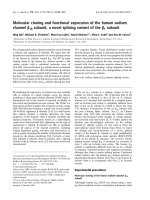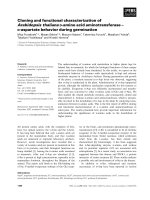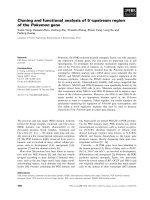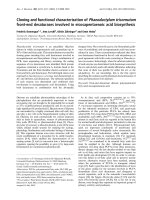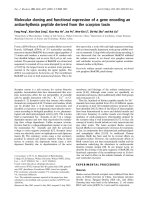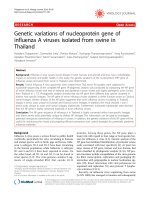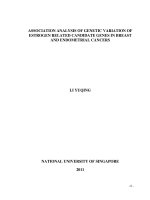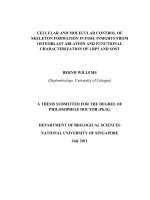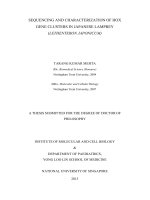Genetic study of hematopoiesis in zebrafish characterization of zebrafish udu mutant, positional cloning and functional study of udu gene
Bạn đang xem bản rút gọn của tài liệu. Xem và tải ngay bản đầy đủ của tài liệu tại đây (5.97 MB, 167 trang )
GENETIC STUDY OF HEMATOPOIESIS IN ZEBRAFISH
— CHARACTERIZATION OF ZEBRAFISH UDU MUTANT,
POSITIONAL CLONING AND FUNCTIONAL STUDY OF UDU GENE
LIU YANMEI
NATIONAL UNIVERSITY OF SINGAPORE
2006
GENETIC STUDY OF HEMATOPOIESIS IN ZEBRAFISH
— CHARACTERIZATION OF ZEBRAFISH UDU MUTANT,
POSITIONAL CLONING AND FUNCTIONAL STUDY OF UDU GENE
LIU YANMEI
(Master of Medicine, Peking University, China)
A THESIS SUBMITTED
FOR THE DEGREE OF DOCTOR OF PHILOSOPHY
INSTITUTE OF MOLECULAR AND CELL BIOLOGY
DEPARTMENT OF BIOLOGICAL SCIENCES
NATIONAL UNIVERSITY OF SINGAPORE
Acknowledgements
I would like to express my sincere gratitude to my supervisor Dr. Zilong Wen for his
great guidance, encouragement, support and patience during my Ph.D studies. I am
also deeply grateful to my Ph.D committee members, Dr. Jinrong Peng, Dr. Sudipto
Roy and Dr. Yun-Jin Jiang for their constructive discussions and valuable advice.
I greatly appreciate the past and present lab members for their kind concern, helpful
discussions and invaluable friendship. Especially I want to thank Linsen Du and
Bernard Teo for their excellent cooperation with me in this project. Special thanks
also go to Dr. Motomi Osato (Lab of molecular oncology), who made great
contribution to cell cycle and cytology analysis of hematopoietic cells. I also would
like to express my heartful gratitude to our genetic screen team, both in our lab: Feng
Qian, Hao Jin, Fenghua Zhen, Jin Xu and Dr. Peng’s group: Lin Guo and Honghui
Huang. I also appreciate Dr. Haiwei Song for protein domain analysis, Dr. Chengjin
Zhang for her pioneer work in our lab.
I am deeply grateful to fish facility, sequence facility as well as administration of
IMCB and TLL (ex-IMA) for their great service. I appreciate the high level training of
Ph.D program provided by TLL (ex-IMA) and IMCB and thank all the teachers in the
graduate courses. Many thanks go to my dear friends and all the people ever helped
me in TLL (ex-IMA) and IMCB. Especially, I want to thank my best friend, Meipei
She for her kind help in my studies, work and life.
i
I owe my every progress to my dearest parents for their self-giving love, constant
encouragement, inculcation and understanding. Especially, during my thesis writing
and also pregnancy period, my mother comes to take care of me and make me
concentrating on the thesis writing. I would like to give my loving gratitude to my
husband Jifeng. Although he is studying in Germany and not around me, he never
stops supporting me, encouraging me and discussing with me in my project. Lastly, I
also want to thank my baby daughter, whose coming brings me great courage to deal
with all the difficulties.
ii
Table of Contents
Acknowledgement
i
Table of Contents
iii
Summary
vi
List of Tables
viii
List of Figures
ix
List of Abbreviations
xi
List of Publication
xiv
Chapter Ⅰ Introduction............................................................................................1
1.1 Hematopoiesis in mammals.................................................................................................1
1.1.1 Hematopoiesis: definition and significance..............................................................1
1.1.2 Two waves of hematopoiesis: primitive and definitive ............................................2
1.1.2.1 Hematopoietic stem cells derive from ventral mesoderm .............................2
1.1.2.2 Primitive hematopoiesis ................................................................................5
1.1.2.3 Definitive hematopoiesis ...............................................................................6
1.1.3 Putative hemangioblast.............................................................................................9
1.1.4 Hematopoietic stem cells..........................................................................................9
1.1.4.1 Origin of Hematopoietic stem cells...............................................................9
1.1.4.2 Lineage differentiation of Hematopoietic stem cell ....................................11
1.1.5 Erythropoiesis.........................................................................................................15
1.1.6 Myeloid lineage development ................................................................................18
1.1.7 T Lymphocyte development ...................................................................................20
1.1.7.1 T lymphopoiesis ..........................................................................................20
1.1.7.2 Thymus organogenesis ................................................................................23
1.2 Genetic study of hematopoiesis in Zebrafish ....................................................................25
1.2.1 Zebrafish is a powerful model to study hematopoiesis ..........................................25
1.2.2 Primitive hematopoiesis in zebrafish......................................................................26
1.2.2.1 Primitive erythropoiesis ..............................................................................26
1.2.2.2 Primitive myelopoiesis ................................................................................28
1.2.3 Definitive hematopoiesis in zebrafish ....................................................................29
1.2.4 Genetic methods to study hematopoiesis in zebrafish............................................32
1.2.4.1 Mutagenesis Screening................................................................................32
1.2.4.1.1 Zebrafish Genomics .........................................................................34
1.2.4.1.2 Principles of Positional Cloning .......................................................35
1.2.4.2 Morpholinos ................................................................................................37
iii
1.2.4.3 Transgenic Reporters...................................................................................37
1.2.4.4 Targeting Induced Local Lesions In Genomes (TILLING) .........................38
1.2.5 Important zebrafish hematopoietic mutants ...........................................................39
1.2.5.1 HSC mutants ...............................................................................................39
1.2.5.2 Erythroid progenitor mutants ......................................................................41
1.2.5.3 Late stage erythrocyte mutants....................................................................43
1.3 Aims of the study...............................................................................................................45
Chapter Ⅱ Materials and Methods........................................................................46
2.1 Zebrafish maintenance and embryo culture ......................................................................46
2.2 Whole-mount in situ hybridization (WISH) and o-dianisidine staining............................46
2.2.1 Digoxigenin (DIG)-labeled RNA probe synthesis..................................................46
2.2.2 WISH procedure for rag1 screening ......................................................................47
2.2.3 High-resolution WISH protocol .............................................................................48
2.2.4 o-Dianisidine staining of hemoglobin ....................................................................49
2.3 Genetic Screen ..................................................................................................................51
2.3.1 ENU mutagenesis...................................................................................................51
2.3.2 Generation of F1 fish and F2 families....................................................................51
2.3.3 rag1 screen .............................................................................................................52
2.3.4 Outcrossing to generate F3, F4, and F5 progeny....................................................52
2.4 Positional cloning of wz260 ..............................................................................................53
2.4.1 Generation of mapping families and collection of the embryos.............................53
2.4.2 DNA preparation ....................................................................................................53
2.4.3 Bulk segregation analysis (BSA) ...........................................................................54
2.4.4 Linkage analysis with single mutant embryos........................................................54
2.4.5 Searching for the contigs and clones containing the mutant gene..........................58
2.4.6 Identification of the mutant gene by sequencing analysis ......................................59
2.5 Amplification of udu cDNA and the related plasmid construction....................................59
2.5.1 Total RNA extraction from embryos ......................................................................59
2.5.3 Cloning of udu cDNA constructs containing the wild type allele and the udusq1zl
allele (pcDNA3.1- udu-wt, pcDNA3.1- udu-T2976A) ...................................................61
2.5.4 Cloning of Flag-tagged and HA-tagged udu cDNA constructs
(pcDNA3.1-N-Flag-udu-wt and pcDNA3.1-C-HA-udu-wt) and SANT-L domain
deficient mutant construct (pcDNA3.1-udu-ΔSANT-L) .................................................62
2.6 udu cRNAs rescue experiments ........................................................................................62
2.6.1 Synthesis of udu cRNAs.........................................................................................62
2.6.2 microinjection.........................................................................................................64
2.6.3 Evaluation of the rescue efficiency and genotyping analysis .................................64
2.7 Morpholino knockdown ....................................................................................................64
2.8 Acridine orange staining....................................................................................................68
2.9 FACS, cytology, and cell cycle analysis............................................................................68
2.10 Cell transplantation .........................................................................................................69
2.11 Northern blot analysis of udu transcripts.........................................................................70
2.11.1 RNA Preparation ..................................................................................................70
2.11.2 Dig-labeled RNA Probe Preparation ....................................................................70
iv
2.11.3 Northern blot ........................................................................................................70
2.12 Generation of rabbit anti-udu antibodies.........................................................................72
2.12.1 GST-fusion protein expression and purification...................................................72
2.12.2 Immunization of rabbits with GST-Udu-N/C-Antigen.........................................73
2.12.3 Antibody affinity purification...............................................................................73
2.13 Western blot analysis of Udu protein expression in transfected cells..............................74
2.13.1 Extraction of proteins from cultured cells transfected with udu constructs .........74
2.13.2 Western blot..........................................................................................................75
2.14 Immunohistochemistry staining ......................................................................................75
2.15 Affymetrix Array .............................................................................................................76
2.16 Real time PCR and Semi-quantitative RT-PCR...............................................................76
Chapter Ⅲ Genetic Screen for T lymphocyte deficient mutants.........................78
3.1 Results ...............................................................................................................................78
3.1.1 Genetic screen for rag1-deficient mutants .............................................................78
3.1.2 Data management ...................................................................................................80
3.1.3 Preliminary characterization of the rag1-deficient mutants ...................................82
3.2 Discussion .........................................................................................................................87
Chapter Ⅳ Characterization of udu mutant embryo, positional cloning and
functional study of udu gene .....................................................................................91
4.1 Results ...............................................................................................................................91
4.1.1 Characterization of udu mutant ..............................................................................91
4.1.1.1 Morphological phenotype of wz260 and complementary test between wz260
and ugly duckling (udutu24) ......................................................................................91
4.1.1.2 Primitive hematopoietic hypoplasia in udu-/- mutant...................................93
4.1.1.3 Abnormal proliferation and differentiation of hematopoietic cells in udu-/- 94
4.1.2 Identification of the udu mutant gene...................................................................100
4.1.2.1 Positional cloning of udu gene ..................................................................100
4.1.2.2 Confirmation of identity of the udu gene by cRNA rescue and morpholino
knockdown ............................................................................................................111
4.1.3 Functional study of udu gene ...............................................................................111
4.1.3.1 Expression pattern of udu..........................................................................111
4.1.3.2 Cell-autonomous erythroid defect in the udu-/- mutant..............................115
4.1.3.3 The udu gene encodes a putative transcriptional modulator......................118
4.1.3.4 The udu-/- erythroid defect is mediated by a p53-dependent pathway .......119
4.2 Discussion .......................................................................................................................130
4.2.1 Analysis of the hematopoietic phenotype of udu mutant .....................................130
4.2.2 Cell-autonomous role of udu gene in erythropoiesis............................................131
4.2.3 The putative molecular mechanism involving Udu protein .................................132
4.2.4 The possible relationship between Udu and p53 ..................................................133
4.2.5 The Udu homologue GON4L may be associated with tumor development .........135
4.2.6 Essential role of Udu in proliferation and differentiation of erythroid lineage ....136
Reference list……………………………………………………………………….…………137
v
Summary
Vertebrate hematopoiesis is a highly conserved process that requires a series of cell
specification, proliferation and differentiation. The underlying mechanisms governing
these cellular events are, however, not fully understood. Recently, zebrafish (Danio
rerio) has emerged as a good genetic model organism to study the early events of
blood formation during vertebrate development.
In order to study hematopoiesis, we carried out a whole-mount in situ hybridization
(WISH) based forward genetic screen to isolate the rag1-deficient mutants. From
screening 540 genomes, we identified 86 rag1-deficient mutants from 540
mutagenized genomes. By observing blood circulation, wz260 mutant was identified
as the only mutant that also had defects in primitive erythropoiesis. Therefore I
selected wz260 for detailed characterization and found that it was a new allele (udusq1zl)
of ugly duckling (udutu24), which was first isolated from the 1996 Tuebingen
large-scale screen as a mutation affecting morphogenesis during gastrulation and tail
formation. WISH to detect the hematopoietic markers indicated that both primitive
erythropoiesis and myelopoiesis were impaired in udusq1zl homozygous mutants. Cell
cycle, cytology, and transplantation analyses showed that the primitive erythroid cells
in the udusq1zl homozygous mutants were severely defective in proliferation and
differentiation in a cell-autonomous fashion. Positional cloning revealed that the udu
gene encodes a novel protein of 2055 amino acids (aa) that contained several
vi
conserved regions, including two Paired Amphipathic-Helix like (PAH-L) repeats and
a putative SW13, ADA2, N-Cor and TFIIIB-like (SANT-L) or a Myb-like DNA
binding domain (This domain is referred as SANT-L thereafter). I further found that
the Udu protein is predominantly localized in the nucleus and deletion of the putative
SANT-L domain abolishes its function. Moreover, robust elevations of the tumor
suppressor p53 expression as well as several p53 downstream targets were observed
in the udu-/- mutant embryos. Knockdown of p53 protein expression by p53 antisense
morpholino oligos (MO) could correct the mutant phenotype to the same extent as
udu RNA injections in mutant embryos. Thus, these results indicate that the Udu
protein plays a crucial role in regulating the proliferation and differentiation of
erythroid cells through a p53-dependent pathway.
vii
List of Tables
Table 2.1
List of Constructs for antisense RNA Probes
50
Table 2.2
Duration of Proteinase K Permeabilization for Zebrafish 50
WISH
Table 2.3
300 pairs of SSLP markers used for BSA
55
Table 2.4
The polymorphic SSLP/SNP markers used for udu mapping
60
Table 2.5
Primers for 5’and 3’RACE of udu gene
63
Table 2.6
Primers for cloning of udu cDNA constructs
63
Table 3.1
Summary of rag1 genetic screen
81
Table 4.1
Rescue results
112
Table 4.2
Summary of cell transplantation analysis
117
Table 4.3
Summary of down-regulated genes in udu-/- mutant
123
Table 4.4
Summary of up-regulated genes in udu-/- mutant
126
viii
List of Figures
Figure 1.1
The hematopoietic hierarchy
13
Figure 1.2
Hematopoietic program in zebrafish
31
Figure 1.3
Outline of forward genetic screen in zebrafish
33
Figure 1.4
Bulk segregation analysis to isolate linked SSLP
36
Figure 2.1
Cloning strategy of udu constructs
65
Figure 3.1
Expression of rag1 in zebrafish
79
Figure 3.2
Detection of rag1 expression in wild type and mutant embryos
79
Figure 3.3
Database management of rag1 screen
83
Figure 3.4
o-dianisidinestaining of 2dpf wild type and mutant wz260 (udu) 84
embryos
Figure 3.5
Expression of hoxa3 and foxn1 in zebrafish
85
Figure 3.6
foxn1 condensed expression pattern in some mutant embryos
86
Figure 3.7
Twelve rag1-deficient
morphology.
Figure 4.1
Morphological phenotype of udu (wz260) mutant
92
Figure 4.2
Primitive erythropoiesis is impaired in the udu-/- mutant
95
Figure 4.3
Myelopoiesis is defective in the udu-/- mutant
96
Figure 4.4
Extensive cell deaths in the CNS but not in the ICM in the 98
udu-/- mutant
Figure 4.5
The udu-/- erythroid cells are defective in cell proliferation and 99
differentiation
Figure 4.6
BSA identified that the udu mutation was linked to SSLP 102
marker z10036 (A) and z1215 (B) on linkage group 16
mutants
with
relatively
normal 88
ix
Figure 4.7
Single embryo linkage analyses of marker z10036 (A) and 103
z1215
Figure 4.8
The genetic map T51 and MGH provided by ZFIN
104
Figure 4.9
Fine mapping using z17246 and SSLP-S16
105
Figure 4.10
Alignment of North Contig #9751 and South Contig #10178
107
Figure 4.11
Positional cloning and gene structure of udu gene
108
Figure 4.12
The
nonsense
mutation
in
Ensemble
Gene 108
tu24
ENSDARG00000005867 (udu gene) in udu
and udusq1zl
mutants
Figure 4.13
udu cDNA sequence
Figure 4.14
Confirmation of the udu gene by cRNA rescue and morpholino 112
knockdown
Figure 4.15
The temporal and spatial expression of the udu gene during 114
early zebrafish development
Figure 4.16
Northern blot analysis of udu mRNA expression at different 114
stages of zebrafish
Figure 4.17
Western blot examination of purified anti-Udu-N and
116
C-Antigen polyclonal antibodies by recognizing the untagged
Udu-N-Antigen and Udu-C-Antigen.
Figure 4.18
Western blot analysis of the ectopic expressed Udu protein in 116
293T cells.
Figure 4.19
Sequence alignment of the zebrafish Udu, human and mouse 120
GON4L proteins
Figure 4.20
The Udu protein is a putative transcriptional modulator
Figure 4.21
Verification of elevated p53 and its target gene expressions in 128
the udu-/- mutant embryos by semi-quantitative RT-PCR
Figure 4.22
The hematopoietic phenotype of the udu-/- mutant is mediated 129
by a p53-dependent pathway
109
122
x
List of Abbreviations
aa
AGM
ALM
AO
AP
BAC
BCIP
BCS
BFU-E
BL-CFC
bls
BM
BMP
bp
BPA
BSA
cdy
CFU-E
CFU-S
cha
cia
clo
CLP
cM
CMP
CNS
DEPC
Dhh
DIG
DN
DNA
dNTP
DP
dpc
dpf
drc
dsm
DTT
ECM
EDTA
EGFP
amino acid
aorta-gonad-mesonephros
anterior lateral mesoderm
acridine orange
alkaline phosphatase
bacterial artificial chromosome
5-bromo-3-chloro-3-indolyl phosphate
bovine calf serum
bust-forming unit-erythroid
blast colony-forming cells
bloodless
Bone marrow
Bone morphogenetic factor
base pair
Burst promoting activity
bulk segregation analysis
chardonnay
colony forming unit-erythroid
colony-forming unit-spleen
chablis
chianti
cloche
common lymphoid progenitor
centimorgan
common myeloid progenitor
central nervous system
diethylpyrocarbonate
Desert hedgehog
digoxygenin
Double-negative
deoxyribonucleic acid
deoxyribonucleotide triphosphate
Double-positive
day postcoitum
days post fertilization
dracula
desmodius
dithiothreitol
extracellular matrix
ethylenediaminetetraacetic acid
enhanced green fluorescent protein
xi
EKLF
ENU
EPO
ES
FACS
FBS
FGF
FOG
frx
GATA-1
G-CSF
GFP
GM-CSF
GMP
HEB
HEPES
hpf
hr
HSC
ICM
Ihh
IL-3
IPTG
kb
kgg
Lin-/lo
Lmo2
LTR
M
M-CSF
MEP
mg
min
ml
MO
mon
mot
mpo
mRNA
NBT
NK
nl
NTP
O/N
Erythroid Kruppel-like Factor
N-ethyl-N-nitrosourea
Erythropoietin
embryonic stem
fluorescence-activated cell sorting
fetal bovine serum
fibroblast growth factor
Friend of GATA-1
freixinet
GATA-binding protein 1
granulocyte colony-stimulating factor
green fluorescent protein
granulocyte macrophage-colony stimulating factor
granulocyte-monocyte progenitor
Hela E-box Binding protein
4-(2-hydroxyethyl)-1-piperazineethanesulfonic acid
hours post fertilization
hour
hematopoietic stem cell
intermediate cell mass
Indian hedgehog
interleukin-3
isopropyl b-D-thiogalactopyranoside
kilo base pair
kugelig
lineage marker-/lo
lim-only protein 2
long-term multilineage repopulating
mole per liter
macrophage colony-stimulating factor
megakaryocyte-erythrocyte progenitor
milligram
minute
milliliter
morpholino oligo nucleotides
moonshine
merlot
myeloperoxidase
messenger ribonucleic acid
nitroblue tetrazolium
nature killer
nanolitre
ribonucleotide triphosphate
overnight
xii
PAH-L
PBS
PCR
PFA
PLM
PTU
rag1
RBI
ret
ris
RT
RT-PCR
SANT-L
sau
SCF
SCL
SDF-1
SDS
SNP
spt
SSC
SSLP
TCR
TdT
TEC
TECK
TGF-β
TIF1γ
TILLING
TPO
udu
UROD
UV
VE
vlt
weh
WGS
WISH
wt
YC
yqe
μg
μl
Paired Amphipathic-Helix like
phosphate-buffered saline
polymerase chain reaction
paraformaldehyde
posterior lateral mesoderm
1-phenyl-2-thiourea
recombination activating gene 1
rostral blood island
retsina
riesling
room temperature
reverse transcription polymerase chain reaction
SW13, ADA2, N-Cor and TFIIIB-like
sauternes
stem cell factor
stem cell leukemia hematopoietic transcription factor
stromal cell-derived factor-1
sodium dodecyl sulfate
single nucleotide polymorphism
spadetail
sodium chloride-trisodium citrate solution
simple sequence length polymorphism
T-cell receptor
Terminal deoxynucleotidyl transferase
thymic epithelial cells
thymus-expressed chemokine
transforming growth factor-β
transcriptional intermediary factor 1γ
Targeting Induced Local Lesions In Genomes
thrombopoietin
ugly duckling
uroporphyrinogen decarboxylase
ultraviolet
visceral endoderm
vlad tepes
weissherbst
whole genome shotgun
whole-mount in situ hybridization
wild-type
yolk sac
yquem
microgramme
microlitre
xiii
List of Publication
Yanmei Liu, Linsen Du, Motomi Osato, Eng Hui Teo, Feng Qian, Hao Jin, Fenghua
Zhen, Jin Xu, Lin Guo, Honghui Huang, Jun Chen, Robert Geisler, Yun-Jin Jiang,
Jinrong Peng and Zilong Wen. The Zebrafish udu Gene Encodes a Novel Nuclear
Factor and Is Essential for Primitive Erythroid Cell Development. Blood. In press.
xiv
Chapter Ⅰ Introduction
1.1 Hematopoiesis in mammals
1.1.1 Hematopoiesis: definition and significance
Hematopoiesis is the development of blood cells and other formed elements of blood.
Hematopoietic cells consist of erythrocytes, monocytes, neutrophils, basophils,
eosinophils, mast cells, magakaryocytes, nature killer (NK) cells, T and B
lymphocytes. And they display distinctive functions, for example, erythrocytes deliver
oxygen, platelets form blood clot, some myeloid cells scavenge debris as well as
pathogens, and lymphocytes regulate the host specific immune reactions. Despite their
wide functional diversities, all of the blood cells are derived from a common
precursor cell — hematopoietic stem cell (HSC) (Kondo et al., 2003). So,
hematopoiesis embraces two aspects: the development of the first HSCs from
nonhematopoietic tissue in embryonic and fetal life, as well as differentiation of
multipotent, self-renewing HSCs into all lineages of the blood.
Hematopoiesis research has been always at the forefront of basic science, helping us
to understand cell biology, molecular biology, genetics, and protein structure and
formation. On the other hand, from the clinical point of view, a basic understanding of
the biology of blood cells is essential for developing new therapeutic approaches for
treatment of the hematopoietic diseases, such as thalassemia, immunodeficiency and
leukemia. For instance, HSC or bone marrow transplantation has been used to treat
the leukemia patients efficiently. Therefore, hematopoiesis study definitely provides a
promising future for basic science as well as clinical medicine.
1
In the past few decades, studies in several species, including mammals, birds, and
amphibians, have shown that hematopoiesis is considerably conserved throughout
vertebrate evolution. The best understood vertebrate hematopoietic system is that of
the laboratory mouse (Mus musculus), and recently the zebrafish (Danio rerio) has
emerged as another excellent model organism for studying hematopoiesis (Lensch and
Daley, 2004). Thus, I will mainly introduce hematopoiesis in the mouse and zebrafish
in this chapter.
1.1.2 Two waves of hematopoiesis: primitive and definitive
Vertebrate hematopoiesis has two successive waves, primitive and definitive, that
differ in anatomic location and the cell types produced. In mammals, the first or
primitive wave of hematopoiesis, is transitory, occurs in the extraembryonic
structure-yolk sac (YS), and produces nucleated primitive erythrocytes, some
macrophages and rare megakaryocytes (Palis and Yoder, 2001; Xu et al., 2001;
Medvinsky et al., 1993; Moore and Metcalf, 1970). The second or definitive wave of
hematopoiesis is persistent, initiates from the aorta-gonad-mesonephros (AGM)
region, then transits to the liver, thymus, spleen, and finally, moves to the bone
marrow. Definitive hematopoiesis generates all mature blood cells (Johnson and
Moore, 1975; Lensch and Daley, 2004; Medvinsky et al., 1993; Godin et al., 1993).
1.1.2.1 Hematopoietic stem cells derive from ventral mesoderm
HSCs are specified early in embryogenesis from ventral mesoderm. As the
undifferentiated, self-renewing cells, mesoderm will give rise to stem cells for the
blood, mesenchyme, kidney, muscle, and notochord (from ventral to dorsal) (Zon,
1995). The understanding of ventral mesoderm induction comes mainly from studies
2
in Xenopus. The unfertilized Xenopus egg is radially symmetric with a dark
pigmented animal hemisphere and a lightly colored yolky vegetal hemisphere. Sperm
entry initiates a rotation of the cortex of the egg with respect to the internal cytoplasm.
This cortical rotation results in the dorsal side being defined by the formation of the
Nieuwkoop center in the vegetal region on the side opposite sperm entry (Huber and
Zon, 1998; De Robertis and Kuroda, 2004). At blastula stage, vegetal signals, which
are maternally derived and separated into ventral-vegetal and dorsal-vegetal signals,
induce the equatorial cells (known as the marginal zone) to form dorsal and ventral
mesoderm. Fibroblast growth factor (FGF) may be the ventral-vegetal signal that
induces mesoderm with ventro-lateral character. Vg-1, activin, two members of the
transforming growth factor-β (TGF-β) family, and Wnt11, a member of the Wg/Wnt
proteins (Heasman, 2006), are likely to be the main dorsal-vegetal signals, through
which the Nieuwkoop center specifies the Spemann’s organizer and the dorsal
mesoderm (Huber and Zon, 1998; De Robertis and Kuroda, 2004). At the gastrula
stage, bone morphogenetic factor 4 (BMP4), another TGF-β family member, is
expressed in the ventral and lateral marginal zones as a ventral mesoderm-patterning
factor. BMP4 RNA and cDNA injections ventralize embryos while dominant negative
BMP4 receptor injections dorsalize embryos. In combination with mesoderm inducers,
such as FGF and activin, BMP4 yields abundant hematopoietic mesoderm. BMP4
activity is inhibited by at least three factors, chordin, follistatin and noggin, secreted
from the Spemann’s organizer, the dorsal gastrula center (De Robertis and Kuroda,
2004; Huber and Zon, 1998). The ventral-mesoderm patterning by BMP4 is mediated,
at least in part, by members of the Mix and Vent families of homeobox transcription
factors. Following gastrulation, a subset of ventral mesoderm is specified to become
HSCs (Davidson and Zon, 2000).
3
In mouse, mesoderm is formed from cells migrating through the primitive streak
between the presumptive ectoderm and the endoderm. The same layer of mesoderm
extends both into the embryo and extraembryonically, into the YS. In mouse, around
7.0-7.5 day postcoitum (dpc), the extraembryonic mesodermal cells in association
with the visceral endoderm (VE) form the blood islands, where primitive
hematopoiesis takes place. Structurally, blood islands consist of clusters of
hematopoietic cells surrounded by endothelial cells (Lensch and Daley, 2004).
TGF-β1 and BMP4 have been shown to be required for blood-island formation in the
mouse embryo. In TGF-β1 and BMP4 mutant embryos, both blood and endothelial
cell developments are compromised (Dickson et al., 1995; Winnier et al., 1995).
Tissue recombination experiments performed in the mouse establish more directly
that VE is required for induction of hematopoiesis in the gastrulation embryo
(Belaoussoff et al., 1998). Around the onset of gastrulation, induction of primitive
hematopoiesis from ectoderm (more specifically, nascent mesoderm cells arising from
the primitive streak) requires the presence of VE. And this VE signaling is only
required in a relatively narrow window of time, since blood formation is autonomous
to mesectoderm by mid-streak stage. Surprisingly, VE signals can respecify the
anterior epiblast (prospective neural ectoderm) to posterior cell fates, formation of
blood and endothelial cells (Belaoussoff et al., 1998). Recently, Indian hedgehog
(Ihh), expressed in VE of gastrulating mouse embryos and mature yolk sacs, was
identified to be the VE secreted signal sufficient to induce formation of hematopoietic
and endothelial cells. Strikingly, Ihh can also respecify anterior epiblast along
hematopoietic and endothelial lineages. Bmp4, upregulated in response to Ihh signals,
4
may mediate activation of hematopoietic and vascular development. Although Ihh
alone is sufficient to induce the development of hematopoiesis and vasculogenesis,
analysis of mice deficient in Ihh shows that Ihh is not essential in these processes,
suggesting that another hedgehog protein, perhaps Desert hedgehog (Dhh), or a
distinct pathway must at least partially compensate for Ihh function (Dyer et al.,
2001).
1.1.2.2 Primitive hematopoiesis
As mentioned above, murine primitive or embryonic wave of hematopoiesis occurs at
around 7-7.5 dpc in the YS blood islands derived from ventral mesoderm, and
produces primitive erythrocytes, macrophages and rare megakaryocytes (Palis and
Yoder, 2001; Xu et al., 2001; Medvinsky et al., 1993; Moore and Metcalf, 1970).
Compared with the definitive red blood cells, the primitive erythroid cells are larger
and remain nucleated (Lensch and Daley, 2004). These cells express 3 hemoglobin
tetrameric complexes known as EI (ζ2ε2), EII (α2ε2), and EIII (α2βH12). ε and βH1 are
embryonic forms of β-globin-like hemoglobin; ζ and α are embryonic and adult forms
of α-globin-like hemoglobin, respectively (Fantoni et al., 1967). The embryonic forms
of hemoglobin are uniquely adapted to the diffusion-limited, oxygen-poor
microenvironment of the embryo prior to circulation (Leder et al., 1980). This early
erythroid cells require the stimulation of burst promoting activity (BPA), a erythroid
growth factor intrinsic produced by the YS (Labastie et al., 1984). In the contrast,
erythropoietin (Epo), which is important for definitive erythroid cell survival and
proliferation, is not required for this early red blood cell activity and not provided by
the YS environment (Lin et al., 1996; Wu et al., 1995).
5
Prior to the emergence of primitive erythroblast, several genes important for
hematopoiesis begin to express in the YS. These genes include stem cell leukemia
hematopoietic transcription factor (Scl), the receptor tyrosine kinase Flk-1, which are
expressed in both endothelial and hematopoietic progenitors (Shalaby et al., 1995;
Shalaby et al., 1997; Shivdasani et al., 1995), and the transcription factors
GATA-binding protein 1 (Gata-1) and Brachyury that are specifically expressed in the
hematopoietic cells (Palis et al., 1999). Knockout of Flk-1 abolishes the formation of
both vascular and hematopoietic lineages, although mesoderm formation appears
intact (Shalaby et al., 1995; Shalaby et al., 1997). Targeted disruption of Scl results in
absence of embryonic hematopoietic cells, while the initiation of endothelial cell and
vascular formation are normal. However, yolk sac vessel patterning is perturbed
(Shivdasani et al., 1995). The studies of the hematopoietic potential of homozygous
mutant embryonic stem (ES) cells in chimeric mice demonstrate that both Flk-1 and
Scl are also required for adult hematopoiesis (Porcher et al., 1996; Robb et al., 1996;
Shalaby et al., 1997). Mutation of Gata-1 affects both primitive and definitive
erythropoiesis (Fujiwara et al., 1996; Pevny et al., 1991).
With development of the embryonic vasculature and initiation of cardiac contractions
at 8.25dpc, the nucleated primitive red blood cells enter the circulation around 8.5dpc,
persisting beyond the establishment of liver hematopoiesis (10.0dpc) and nearly
absent at 15dpc (Ji et al., 2003).
1.1.2.3 Definitive hematopoiesis
Definitive hematopoiesis is believed to originate from the AGM region, which is
derived from the intraembryonic lateral plate mesoderm, as early as 9dpc in mouse
6
(Medvinsky et al., 1993). At 10dpc, the AGM region possesses the long-term
multilineage repopulating (LTR)-HSCs ability, able to rescue long-term blood
formation in transplant recipients (Muller et al., 1994). Between 9.5 and 11dpc, the
HSCs exit the AGM region and seed the fetal liver presumably through blood
circulation (Garcia-Porrero et al., 1995). The liver remains an active hematopoietic
organ until the neonatal period, where HSCs expand and differentiate to various cell
types (Sasaki and Sonoda, 2000). The splenic rudiment is colonized by HSCs at
12dpc, becoming fully hematopoietic at 14.5dpc. The spleen aids in the transition
from fetal liver to bone marrow hematopoiesis, and its activity persists throughout the
life span of mouse (Sasaki and Matsumura, 1988). HSCs derived lymphoid progenitor
cells appear to enter the thymic rudiment continuously from 11dpc and the thymus
remains a lymphopoietic organ throughout life, fundamental to the development of the
T lymphocytes (Douagi et al., 2002). Bone marrow (BM) is colonized by HSCs at
16dpc, and serves as the major organ producing blood cells in the juvenile and adult
mouse (Delassus and Cumano, 1996).
Additionally, definitive hematopoiesis activity was also found in the YS.
Firstly,
before onset of the circulation, small-enucleated cells expressing adult globin, named
as bust-forming unit-erythroid (BFU-E) cells are discovered in the YS at 8dpc (Palis
et al., 1999). These BFU-E cells are then found in blood circulation by 9dpc, and later
in the liver around 11dpc, suggesting this activity comes from the YS (Palis et al.,
1999). Secondly, multipotent progenitors capable of generating myeloid and lymphoid
cells can be detected in the YS at 8.5-9dpc (Galloway and Zon, 2003; Yoder et al.,
1997a). And the YS-derived hematopoietic cells are able to form spleen colonies
(colony-forming unit-spleen, CFU-S activity) after 9dpc. Finally, by 11dpc, the YS
7
harbors LTR-HSCs, which are able to reconstitute all aspects of long-term
hematopoiesis when transplanted into a lethally irradiated host (Yoder et al., 1997b;
Yoder and Hiatt, 1997). Therefore, the YS has the potential of definitive
hematopoiesis.
As mentioned above, Scl and Flk-1 are necessary for both primitive and definitive
hematopoiesis, and Gata-1 is required for both primitive and definitive erythropoiesis
(Pevny et al., 1991; Fujiwara et al., 1996). In contrast, Runx1 and c-Myb are required
for definitive hematopoiesis but not primitive hematopoiesis (Wang et al., 1996;
Mukouyama et al., 1999; Mucenski et al., 1991; North et al., 1999). Both Runx1 and
c-Myb deficient mice display the same hematopoietic phenotype: no hematopoietic
cells generated in the AGM region, fetal liver anemia but normal YS-derived
erythropoiesis (Wang et al., 1996; Mucenski et al., 1991; North et al., 1999). This
indicates that these two genes are involved in the definitive HSCs generation,
maintenance, and proliferation or self-renew. Considering the migratory feature of
definitive hematopoietic cells, some homing molecules must play a role during this
early process. β-1-integrin has been identified to be necessary for the migration of the
hematopoietic cells to the fetal liver as well as to thymus and bone marrow (Fassler
and Meyer, 1995). Additionally, mutations in Jak2 (Neubauer et al., 1998), Epo/EpoR
(Wu et al., 1995; Lin et al., 1996) and Erythroid Kruppel-like Factor (Eklf) (Perkins et
al., 1995) genes disrupt predominately the definitive erythropoiesis. Taken together,
the molecular regulation of hematopoiesis is complex and the differences between
primitive and definitive hematopoiesis may be because of the two anatomically
separated hematopoietic sites: the YS and the AGM region.
8
1.1.3 Putative hemangioblast
Hematopoietic and endothelial cells have a close relationship. These cells
concurrently emerge in the YS and express overlapping sets of genes, including Flk1,
CD34, Scl, Flt1 and Gata-2, indicating that both of these two cell types are derived
from a common precursor, hemangioblast (Cumano and Godin, 2001; Keller et al.,
1999). Targeted disruption of Flk-1 or TGF-β1, resulting in absence of both
hematopoietic and endothelial cell lineages, provides additional evidence for the
existence of hemangioblast (Dickson et al., 1995; Shalaby et al., 1995; Shalaby et al.,
1997). Furthermore, using the ES cell differentiation culture system, the blast
colony-forming cells (BL-CFCs), which are isolated within embryoid bodies
generated from differentiated ES cells, can generate both hematopoietic and
endothelial cells upon culture with appropriate cytokines. Therefore, the BL-CFC
represents the putative hemangioblast. Additionally the BL-CFCs are lost quickly
during the embryoid body development, which may also be the feature of
hemangioblast that makes it difficult to be identified (Choi et al., 1998; Kennedy et al.,
1997). In addition, in vitro culture system shows that TEK+ cells isolated from AGM
and Flk+ cells sorted from ES cells and 9.5dpc YS also have the hemangiogenic
potential (Hamaguchi et al., 1999; Nishikawa et al., 1998). Thus all of this evidence
indicate the existence of hemangioblast.
1.1.4 Hematopoietic stem cells
1.1.4.1 Origin of Hematopoietic stem cells
HSCs are defined by their two abilities: pluripotency and self-renewal. Pluripotency
means that HSCs are able to create progeny of all blood cell lineages. Self-renewal is
that HSCs can undergo cell divisions and generate the daughter cells identical to the
9
